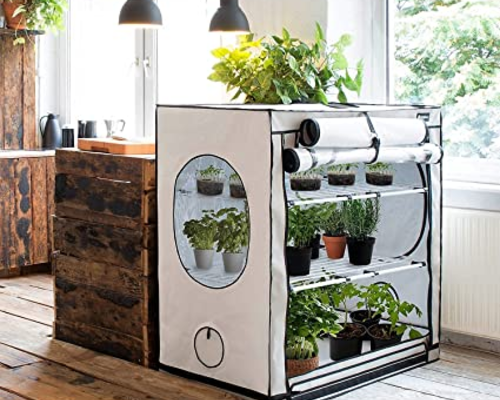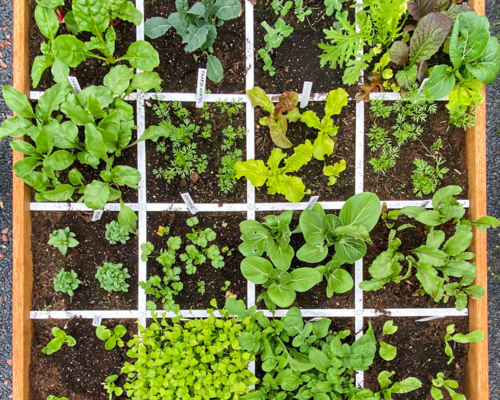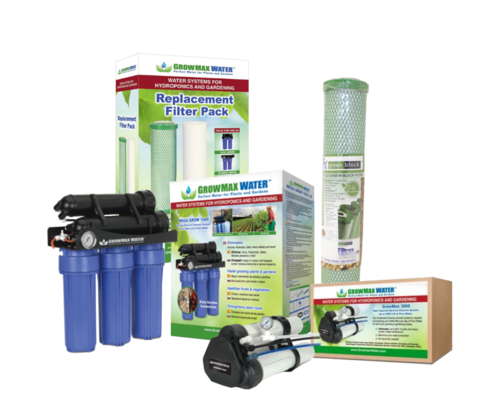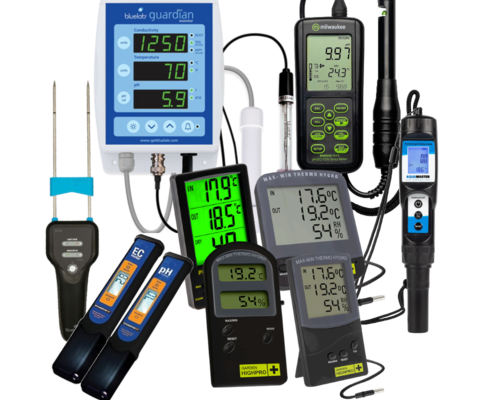To grow your own vegetables, herbs or fruits at home, a grow tent is recommended, you can create the ideal conditions in a grow tent or climate chamber. This is necessary because each type of crop has its own ideal conditions, think about the temperature, humidity or the number of hours you burn your grow light. You create the optimal climate by properly coordinating everything.
What is a grow tent?
A grow tent consists of tent poles and a tent cloth, it's really not much more than that. Some grow tents do come with a water tray, a water tray catches the water that runs out of the pots or is spilled. Peripheral equipment makes your grow tent complete, there is more to a grow than just a grow tent.
A grow tent comes in many different sizes, from square to rectangular grow tents. From 30 by 30 centimeters to 9 by 4.5 meters. This way there is a grow tent for every space. The most continuous size is one meter by one meter with a height of 2 meters. You must pay attention to the height of the grow tents, some grow tents are 1.6 meters high, where other grow tents are 2.4 meters high.
A grow tent is available in many different brands, almost every brand has different editions of tents. Most brands have a budget grow tent, a 'normal' grow tent and a professional grow tent.
Setting up your grow tent
To assemble a grow tent you don't need any tools at all, the poles and corner pieces can easily be slid together. The only thing left of the grow tent is the tent fabric, this goes on last and can sometimes be very tight. This may sound like something negative, but actually this is a very good thing. If the tent fabric is tight, then once you turn on your extraction, the entire tent fabric will not be pulled in. If this does happen you will lose surface area in your grow tent.
What materials are used?
All grow tents are made of quality materials, which is of course necessary with the temperature changes and humidity. For example, the tent poles are made of stainless steel to prevent corrosion, to connect the tent poles together and make the structure sturdy, plastic corner pieces are used. Like the tent poles, these cannot rust. Each brand of grow tent uses different thicknesses of steel as do the different thicknesses of tent cloth used.
The thickness of the tent canvas is indicated by a number and a D, the higher the number the thicker the tent canvas. On the inside of the tent fabric is a reflective mylar layer that keeps artificial light in and also reflects it well. The reflection allows your plants to capture 50 to 95% more light. The makers of the grow tents have thought carefully about the design to ensure that no light can escape from your grow tent, for example, most grow tents have an extra flap at the zipper so that no light can escape from here.
What peripheral equipment do you need?
As mentioned before, only a grow tent is not enough, this is of course only the space in which you are going to start your cultivation. Below we have listed the necessary peripheral equipment, which we will explain later in the blog.
- Grow light and accessories
- Clock timer
- Extractor, carbon filter and air hoses
- Fan / Tube fans
- Thermometer
- pH & EC meter
Grow Light
A grow lamp is not just a lamp, a grow lamp is equipped with the right spectrum. This means that the lamp consists of different diodes that give off different colors. For example, for the growth phase you need blue light where in the flowering phase it is mainly about the red light. Grow lights work with color temperature or Kelvin to indicate this, so your crop in the growth phase needs a high color temperature which is indicated as 5500 to 6500K. The higher the number the brighter the light. For a seedling or cutting to grow well there is a greater need for white light, if this is indicated in Kelvin then you end up with a color temperature of 9500K. For the flowering phase yet another lamp is used, the color that flowering plants require is warmer, this ends up at a color temperature of 2800K. Also, to have the best of both worlds there are 'Full Spectrum' lamps, these lamps have about 3500K and therefore can be used for both growth and flowering.
- 9500K ~ is used for your seedlings or cuttings
- 5500-6500K ~ is used for the growth phase of your crop
- 2800K ~ is used for the flowering phase of your crop
- 3500K ~ can be used for both the growing and flowering phase.
To hang your grow light you will also need hangers for this, this can be a simple string but this is not recommended. You can also order adjustable hangers from us which allows you to easily move your grow light with your crop without having to make too much effort.
LED VS HPS
A grow light is available in different types, the most commonly sold grow lights are LED lights or HPS grow lights. An LED lamp has the advantage that, compared to HPS lamps, it uses little energy and gets much less hot. HPS lamps are the classic grow lights also used in horticulture, nowadays also many LED lamps but this is still emerging.
Switch clock
A timer you definitely need in your cultivation, to mimic nature the lamps should turn on and off by themselves. For example, cuttings and seedlings need 24 hours of light a day to make the roots properly, once your crop enters the growth phase then you need to adjust your timer to 18 hours of light and 6 hours of no light. This will allow your crop to settle down and continue growing the next day. Once your crop needs to enter the flowering phase then set your timer to 12 hours of light and then 12 hours of no light. This will encourage your crop to flower.
Fresh air and extraction
Some crops have a very penetrating odor, of course you do not want to smell this when you are relaxing on the couch. This requires an extractor with a carbon filter, the extractor pulls the air through the carbon filter, this carbon filter filters the air of unpleasant and penetrating odors. To connect the filter and the extractor you need an air hose, this air hose is available in two types, an insulated hose and a non-insulated hose. Which hose you choose is entirely up to you, with an insulated hose you will have less noise pollution.
Besides preventing unpleasant odors, this installation has another very important application. As soon as you turn on your grow light it will generate heat. As mentioned before, every type of crop has its own ideal climate conditions. To create the right climate, heat must also be extracted, this can be done in combination with a 'Fancontroller with temperature sensor' that controls your exhaust on temperature. When the temperature is too high, the suction will increase the suction and cool air will be drawn in, causing the temperature to recover.
A fan ensures the correct air circulation in your grow tent, if you do not use a fan the air does not move enough. There are many different types of fans, you can look at clip fans that you can easily attach to a tent pole in the corners of your grow tent. If you have a little more space you may want to look at a standing fan or a floor fan.
Measuring is knowing
To create the right climate you obviously need to know what the temperature is, this can be measured with a simple thermometer. But temperature is not everything, you also need to monitor your humidity. For this reason, we sell thermometers that also measure humidity. Because measuring is knowing as most people say.
To give the right levels of nutrition to your crop you also need to measure your nutrient water, you do this with a pH and an EC meter. Plant nutrition is necessary for successful growing, plant nutrition gives the water different values. If the values are too high or too low, the plant nutrition will either have almost no effect or a bad effect. This makes a pH or EC meter necessary.
Do you want more information?
Want more information on a specific topic? Check our "Knowledge Center" blog page to see if the information you need is among them. Is the information not in one of our blogs? We have a piece of text with each category where the products are explained in broad terms. The most popular categories are:




